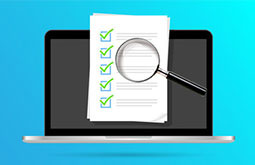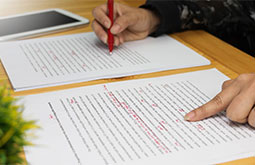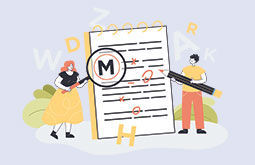How to Proofread Legal Documents? - Some Tips and Guidelines
Legal documents must be error-free. Any misplacement or even the slightest of errors may make the whole thing invalid. Grammatical errors, spelling mistakes, misplaced commas, or faulty sentence structures can also cast a negative light on the agreements and contracts.

A flawed legal document can result in several consequences. First of all, it cannot convey the desired message. Since the information present in legal writing is often complex, it would be more difficult for readers to understand and digest the concept.
That's why it is essential to go through the process of proofreading to ensure your document is readable. The matter should be presented in a neat layout and logical flow must be ensured.
Now, let us delve deeper into how to proofread a legal document the right way.
-
Stick to your style
Different businesses prefer their own unique set of words and usages while writing documents. These writing styles include unique fonts, font sizes, division of paragraphs, capitalized words etc. The difference is evident in the capitalization of important words by some businesses, while others go for bolding or italicizing. These things are not done based on any fixed criteria or grammatical reasons.
It is nothing but a style that is adopted by the business. Therefore, it is important to follow the style throughout the write-up while legal proofreading and copyediting. The style might be derailed when there are more people working on the same document. The trouble starts when all of them are not equally aware of the unique style. The condition gives rise to inconsistency in the final draft. A reader won’t be pleased after reading such a document.
-
Watch out for perplexing words
In English, there are several words with multiple meanings. Few others differ in spelling, but sound the same. In addition, words that sound and look different, but exhibit similar characteristics also exist. It is important to avoid confusion and choose the correct word at the right position.
For example, many people have the tendency to pick those wrong ones when faced with choices like principal vs. principal (same pronunciation, different spellings, different meanings) or access vs. assess (different meanings, spellings and pronunciation, but causes confusion).
Overcoming this dilemma is essential to craft an error-free legal document. A dictionary can be handy. If you don’t have one, look for online versions that are available for free. Make it a point to clarify all doubts before finalizing the document.
-
Employ grammatical elements properly
This is one of the most crucial legal proofreading tips. Grammatical elements should be used properly and failing to do so would reflect poorly on you. Misplaced commas play spoilsport in most cases. Apostrophes should be placed in those right slots. Sadly, these inverted commas baffle many people. A proper idea about the usage of apostrophes can clear the air. Apostrophes signify missing letters in a word.
For example, the word ‘cannot’ is written as ‘can’t’. Similarly, ‘do not’ becomes ‘don’t’ and ‘that is’ becomes ‘that’s’. The indication of possession is another application of apostrophes. Common examples are phrases like John’s house, the shop’s billboard etc.
However, the usage of apostrophe is permitted only after ‘s’, if there are more number of shops or many guys named John. Another extremely common proofreading mistake committed by a surprisingly large number of people is the usage of apostrophes to indicate plurals. Usual examples are usages like apple’s for sale, room’s for rent, beware of dog’s, hundred’s of vehicles etc. The correct usages are apples for sale, rooms for rent, beware of dog and hundreds of vehicles.
-
Avoid common slip-ups
There are other mistakes that creep into documents every now and then. Keeping them at bay is of paramount importance as these slip-ups would be viewed as silly ones and take away sheen of the entire document. Formatting errors are widespread and include irregular margins with poor alignment. A little attention can avoid such situations. Also, ensure that your tab is kept at the right place.
While typing, you will encounter situations where the usage of italics and bold formats are unavoidable. But, the action turns problematic when users forget to switch back to normal fonts. Being in a hurry might aggravate the issue. Also, the numbering should be done in the correct order and it should work well with the text. Appropriate numbering applies to endnotes and footnotes as well. This is to ensure that these are in perfect accordance with what they point to in the text’s main body.
Make sure that you close inverted commas and brackets after use. Usually, people don’t commit these errors due to lack of knowledge. A lack of attentiveness often leads to the menace. In addition, remember to write names, addresses and dates accurately as these can’t be altered. Special caution must be exercised while entering numbers that contain a lot of zeroes or any other recurring digit. Here, chances of typos loom large. So, verify that you are entering the right number. No headings should be left at the bottom without text below them and avoid blank spaces at the end of pages. Typically, companies offering legal document proofreading services have keen eye for such details.
-
Communicate while editing
The importance of communication during the legal document editing and proofreading process may surprise you. It is not verbal communication, but the ability to convey information and facilitate the smooth functioning of the process. This is especially important while handling a team of more than two editors. The inability to convey crucial instructions to team members in a productive manner would definitely disrupt the editing process and impair the final product’s quality.
The role of effective communication comes into play when you are editing a piece for another person. He/she could be a friend, relative, client or any random person. Maybe the person has requested you to just read through the document, mark errors and give feedback on the general style of writing. Even if the person has promised to make corrections accordingly, you can’t afford to have a lax approach. When you spot mistakes, strike them with red ink to ensure that it’s visible. While suggesting alterations, they should be jotted down in neat handwriting. Legible fonts should be used for this.
Clear signals must be provided about the portion of the document you are referring to. Otherwise, the person who is eager to type down the whole thing in a hurry may miss the point. It is a good idea to use symbols and attract attention to the portion that badly needs amendment. Examples are crosses or tick marks. Do you wish to write a comment on the document? Now, what will happen if the other person types the comment and includes it in the essay? It’s evident that he/she must have mistaken the comment for an amendment. You can avoid the difficulties by writing the comment inside a circle. This works great as a professional proofreading tip.
For example, if you wish to say that a particular sentence is unnecessary, put an arrow and write those words somewhere near the sentence. When you do this, encircle those words and prevent them from getting typed. Finally, don’t worry if you have lengthy suggestions or detailed paragraphs about necessary corrections. Do not shorten them due to space constraints.
Get a fresh sheet of paper and pen down your thoughts, recommendations and frustrations in detail. These are popularly termed as riders. The numbering of a rider is based on the original page number. In case of more than one rider, special alphabets are allotted to them. For example, three different riders included in page 1 should be named 1A, 1B and 1C. An indication to the rider must be placed on the main text where it is meant to be placed.
-
Trim down the longer sentences
Legal documents are usually complex. So, using long sentences will only confuse your readers and distract them from the main message. You surely don’t want that, right? So, try to keep your sentences short, precise, and clear. If a sentence is long, you can break it into two.
-
Use an editing checklist
There are hundreds of editing checklists available online. So, browse the internet and choose the one that can be useful for your position or writing tasks. Besides, you can also create it on your own. An editing checklist should mainly involve checking your work related to grammar, spelling, readability, and consistency.
Conclusion
The editorial process for legal documents is indeed tedious. At the same time, attention to detail is the key to developing an error-free and enforceable legally binding document. Proofreading eliminates silly typos and embarrassing grammatical errors. These may sound trivial, but in reality, they can severely tarnish a law firm’s image. These blunders make the law agency appear unprofessional to clients who solicit their service.
Therefore, remember the tips and guidelines mentioned above while proofreading any legal paper or documents to avoid any unfortunate fiasco. Hope this article has imparted the insights required for a legal proofreader.
There are several professional agencies offering excellent copy editing services at nominal costs and a fast TAT. These experts also provide flawless proofreading services using manual efforts and automation alike. They have trained proofreaders with adequate knowledge of legal affairs. Therefore, if you need professional guidance, reach out to these agencies immediately. Make your legal documents free of all errors.




